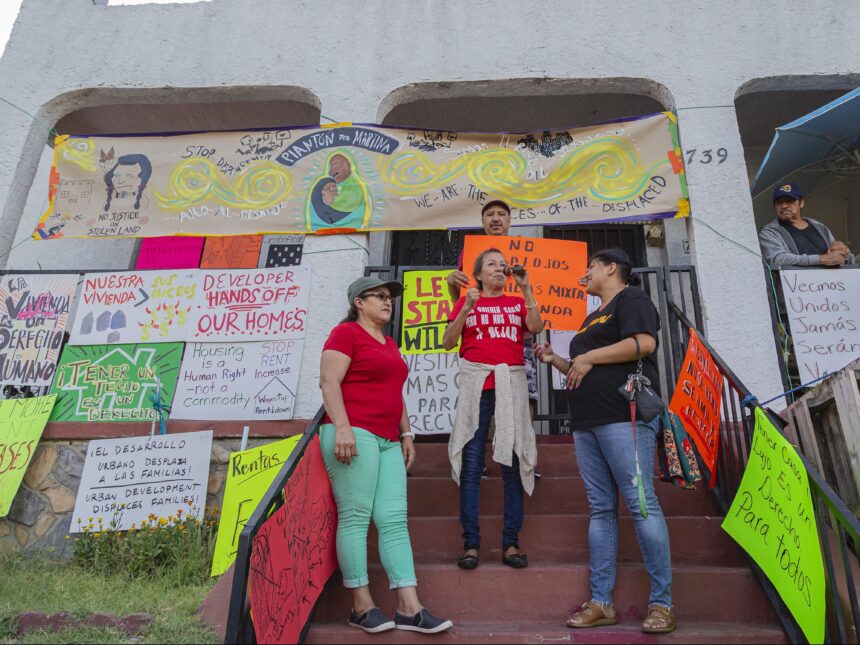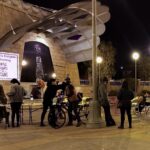Desarmando Desarrollismo: Listening to Anti-Gentrification in Boyle Heights
By Ultra-red

In 2016 the residents of the Pico Aliso public housing in Boyle Heights together with a coalition of neighborhood groups began calling for a boycott against gentrifying businesses in Boyle Heights. Given the number of art galleries among the boycotted businesses, artists and cultural workers from around the city joined in solidarity with local residents. Our art collective, Ultra-red, signed onto the boycott in June 2016 when collective members joined dozens of artists and community members in the Boyle Heights Alliance Against Artwashing and Displacement (BHAAAD). In the two years that BHAAAD existed, we all learned a great deal about how solidarity itself becomes a target.
A common strategy for breaking any resistance movement is to attack the people who join a movement in solidarity. The counter-oppositional strategy has a long and sordid history, often employing stigmatizing rhetoric about “outside agitators.” It implies that the poor would never rise up against their situation unless manipulated and deceived by outsiders driving their own agenda. The poor would never imagine their freedom if not for communists, anarchists, artists, activists, etc. Defenders of the status quo used the same argument against the abolitionists, against the labor movement in the early 20th Century, against the civil rights movement, the immigrant rights movement, the movements of homeless people, and against the struggles of public housing residents.
The attack on solidarity has the specific purpose of isolating those who are most vulnerable in the struggle for change. That the poor who author a struggle can take positions more radical than their supporters is often overlooked. In fact, a pervasive tactic in such a strategy is to erase the agency of the poor altogether. Scanning news reports about the fight against artwashing in Boyle Heights reveals precisely this tactic at work.
With a few notable exceptions, press accounts of the anti-artwashing campaign in Boyle Heights erase the leadership role of public housing residents – most of whom are Latina immigrants. Even artists of color who oppose the boycott omit from their arguments the role of the Pico Aliso women in leading the fight. Instead, press and critics alike place the focus squarely on white artists. The inability to see and hear the voices of people of color, especially women of color, serves as a consistent trope in the “outside agitator” attack on solidarity.
Naming the moment
Any political movement concerned with efficacy will pause to reflect on what artist and popular educator Deborah Barndt once called “naming the moment.” Such a collective process entails listening to the current situation, cut from an eternal present. Naming the moment involves analyzing the moment’s relationship to the structural or, for Gramsci, the “organic” conditions of capitalism’s war against workers and the poor.
The current conjuncture of aburguesamiento, or what the London anti-gentrification collective, Southwark Notes, call “social cleansing,” is neither identical to every other moment nor uniform from one neighborhood to the next. That said, certain conditions to this conjuncture manifest in cities across North America and beyond. Emergent fascism, the rising tide of racist xenophobia, mass deportations, murderous misogyny and homophobia, and the merger of capital with state authoritarianism define the situation for political struggle broadly. In the same moment, gentrification socially cleanses working class, poor, and poor ethnic communities, often at the hand of liberal municipal governments and entrepreneurs within the community. Gentrification attacks the very working class, racial, and ethnic minority communities that historically mobilize and resist fascist regimes out of self-defense. Naming the moment forces us to strategize an opposition to gentrification at a time of rightwing consolidation.
Any conjunctural analysis must also examine the relationship between the people living under the greatest threat and those who author the analysis. A disconnect between the two can result in analyses and strategies that further structural violence. Let’s give an example of what that looks like. Mainstream understandings of the global housing crisis argue that legal protections for renters, such as rent control, have placed too many constraints on development. City requirements for housing affordability, just cause eviction protections, and community planning have resulted in a housing shortage driving the crisis, according to real estate interests and urban planners who support those interests. The analysis dictates its own strategy; build, baby, build. The argument ignores key discrepancies. In states like Texas that bar any rent control or affordability regulations the housing crisis rages just as fiercely as in Los Angeles.
The analysis of the crisis must begin from the experiences of those most affected. This has been a fundamental tenet of social and political movements across time. And yet, such a truth has little persuasion among those who insist on the benefits of gentrification. Instead, the response is consistently, gentrification is inevitable, and there is nothing one can do. At the same time, critics of the anti-gentrification effort reject the insights of the most affected by chastising low-income tenants for pursuing the wrong strategy in their fight.
Any conjuncture of capitalism is not the result of natural forces or the invisible hand of markets. It’s useful to remember Martha Rosler’s criticisms of Richard Florida’s “creative class.” Cities around the world adopted Florida’s template for establishing arts districts in former industrial zones or, in the context of the United States, in neighborhoods defined by white supremacist redlining policies. Just as a patina of interior and exterior design raises the value of a modest house, so too art galleries and arts-oriented businesses flip entire neighborhoods. This process is about as natural as any make-over (and neither is it fool-proof). It is calculated, deliberate, and dependent upon state and investor support. Success also depends upon the magical idea that so-called improvements will benefit those who have been historically exploited by development. Fool us once, shame on you. Fool us again and again and again . . .
A history of repetition prepared the residents of Pico Aliso to resist the arrival of art galleries. The role of artwashing in social cleansing working class and poor neighborhoods in other cities and even elsewhere in Los Angeles (e.g. the North Hollywood Arts District) served as a prophetic warning for what would happen in Boyle Heights. But there were also the historical repetitions in Pico Aliso itself. Historical consciousness taught the Pico Aliso residents that the battle against artwashing would be but the latest in the fight against oblivion.
Through all of these struggles, the Pico Aliso residents have repeatedly issued the same invitation for others within Boyle Heights, across the city, and beyond to stand with them in solidarity.
Listening to the Library for Anti-gentrification
Two years after Marco Larsen and Dont Rhine formed Ultra-red in 1994 in the context of AIDS activism, the collective began collaborating with organizers and residents in Pico Aliso through the community-based organization, Unión de Vecinos. That collaboration attracted a larger group of artists who mounted exhibitions and conducted site-specific actions. Unión de Vecinos organizers Leonardo Vilchis and Elizabeth Blaney joined Ultra-red soon after. Today the Los Angeles team within the larger Ultra-red collective is made up of Blaney, Rhine, and Vilchis as well as Walt Senterfitt who joined the collective in 2010. Walt moved to Boyle Heights after his landlord invoked the Ellis Act to evict all the tenants in his building, many of whom were queer seniors. Dont lives in Hollywood where he has been involved in community organizing beginning with the needle exchange program, Clean Needles Now, in 1992.

In late 2012, Ultra-red convened the community research collective, School of Echoes Los Angeles. For over five years the collective has been home to an active and diverse group of organizers, popular educators, and sometimes artists. In its early years, the members of School of Echoes visited different neighborhoods where they lived as individuals, including Boyle Heights. The group held dialogues with neighbors, friends, and other communities. We listened critically to the discourse of non-profits and developers who claimed that the housing crisis was caused by a shortage of housing and thus required more development, even though development too often displaces the poor and their communities. Out of the group’s research into the causes of gentrification and how it can be resisted, School of Echoes organized the L.A. Tenants Union in the summer of 2015, bringing together diverse tenants in crisis from across the city. Today the union has ten neighborhood chapters on the Westside, Eastside, Vermont and Beverly, Northeast, Hollywood, South Central, Mid-City, East Hollywood, Baldwin Village-Leimert Park-Crenshaw, and North Hollywood.
Recent projects by School of Echoes include Biblioteca de Los Ángeles contra el aburguesamiento (“Los Angeles Library for Anti-gentrification”). This was not an artwork, per se. The library archived materials produced by a number of anti-gentrification political groups active in Los Angeles. School of Echoes intended the library to highlight the larger milieu that is the anti-gentrification movement; a movement that possesses a broad range of tactics as well as divergent and even contradictory analyses. Those contradictions are apparent within the articulations of specific groups, such as those who promoted non-profit housing developments before turning to a more radical analysis around community defense.
While spotlighting groups currently active in Los Angeles, the library also gives evidence to decades of struggle to protect the rights of tenants and to fight for people living on the streets so that they may have a place to call home. The eclectic posters, videos, flyers, and booklets in the library highlight the centrality of low-income households in the struggles against displacement. This includes the fight to protect public housing from demolition and privatization, and to guard public housing residents from displacement.
The library invites visitors to ask why it is only recently that a citywide Tenants Union has formed in Los Angeles? Has the city not needed this kind of movement for a long time? Hasn’t the city needed an alternative to the Non-Profit Corporate Complex (NPCC) that endorsed, promoted, and enforced a consensus amongst Los Angeles’ poor that nothing could be done to push back against speculative development and the racist displacement of people from Hollywood, Echo Park, Highland Park, South Central, etc.?
Visitors to the library could also ask how it is possible that the community who organized Unión de Vecinos has survived without a citywide L.A. Tenants Union or without coalitions such as Defend Boyle Heights. Both the union and Defend Boyle Heights have taken bold positions in pushing back against the violent consensus within the NPCC. In many neighborhoods where L.A. Tenants Union has established chapters, or Locals, working people had been the victims of non-profit organizations that co-opted struggles in order to preserve the neoliberal status quo. What made it possible for the Pico Aliso community to resist such co-optation?
Reviewing the diversity of tactics represented in the library also compels us to ask why it is that Defend Boyle Heights has had to resort to more aggressive tactics to make its points against the tide of displacement hidden within the false utopia of development.
All of these questions and more emerge from listening to the library, both where its voices agree and where they disagree. The library can be seen as a tool to be distributed in an effort to continue the fight to preserve and expand community and housing for all.
Aburguesamiento y desarrollismo
For School of Echoes, the anti-gentrification library allows for reading the past and present of struggle together. Having a historical perspective, one that lives in the fabric of neighborhoods, teaches us that aspects of this moment resonate with prior accumulation processes. Those processes extend beyond city planning and reach deep into the histories of colonialism. Specifically, the resistance to social cleansing in urban neighborhoods overlaps with the histories of resistance to capital’s use of development to extract value from the global margins. This was precisely the analysis of neocolonialism in the 1960s and 1970s that critiqued developmentalism as a tool of imperialist financialization – desarrollismo. However, this is not the part of an anti-colonial critique that most urban theorists refer to when comparing gentrification to colonialism.
We should show caution when using an anti-colonial discourse in the analysis of gentrification. Equating this conjuncture within capitalism to colonialism presents significant risks. The comparison can overlook the specific role of speculative development in the post-2008 financial crisis. As a number of economists have pointed out, the debt-financing that has driven the global economic recovery has gone almost entirely to the global elite through real estate and securities. Thus, speculative development and housing commodification have become pillars in the global economy; subsuming housing’s use-value. This explains the global housing crisis happening right now. Comparing the current situation with colonialism should not obscure the specifics.
Without a sharp critique of developmentalism we are left with a rudimentary, almost cartoonish version of anti-colonialism that often surfaces in conflicts over community development. That form of anti-colonialism claims that only brown people or people of color can invest in communities of color. The claim is no different than that of pink dollars and other forms of comprador capitalism. Many of the people using that discourse are themselves entrepreneurs looking for an opportunity to enter into and profit from the redevelopment game. These entrepreneurs invest in small coffee shops or other types of gentrifying businesses seeking to attract new patrons with disposable income.
People of color who enter the game of speculating on their own community often use anti-colonial or de-colonial tropes in their rhetoric. They fail to see, or refuse to see, the damaging effect their gamesmanship has on the local economy. The investment in speculation and gentrifying businesses forces the closure of small local businesses resulting in local people finding it harder to buy food they can afford and to take care of basic needs. Now they have to travel far away to find another store that gives them credit or where they can buy the diapers and eggs that they need for today.
If the entrepreneur is an artist from the neighborhood, “decolonizing the gallery” becomes an alibi for aspiring to enter into the art economy because they believe that their time has come. Local artists demanding a professional arts infrastructure overlook how such spaces displace low-income households and businesses to make way for galleries, museums, and other arts-oriented institutions.
The counter-histories of artistic resistance in Boyle Heights challenge us to investigate artists who refused to play the part of a capitalist vanguard. Artist collectives like ASCO and the East Los Angeles muralists took their art to the streets to address larger historic questions of identity, or to confront current political and social conditions in solidarity with their community. One can uncover countless histories of artists, such as Self-Help Graphics founder, Sister Karen Boccalero, who oriented their practices towards the agency of those in struggle. Such artists made choices not for the benefit of their place in the market or the canon, but to bring cultural action to political strategy. One can also reflect on the stories of many artists who, facing conflict between the institutions of art versus social justice, embraced the latter.
This brings us back to an anti-colonial analysis and strategy that opposes social cleansing. Like many artists directly engaged in the anti-gentrification movement, those of us in Ultra-red see ourselves at the edge of anti-colonial and dialectical critique. Our position, however, is not one that leads to a pro-development response. Over the years we have challenged ourselves, learning from the deep and bold history of liberation movements. Those movements have argued that stopping social cleansing depends upon saying no to capitalist dependency. All of us in the anti-gentrification movement have much to learn from that part of anti-colonial struggles.
Yes, we need to hear things historically. We need to understand the political economy of galleries and of bourgeois boutiques in comparison with a larger analysis of speculation and dependency. We need to understand how public investment in beautification (i.e. “modernization”) opens the door to gentrification. We need to listen critically to how a “democratic civic engagement” in consultative processes produces value and accelerates development. And we need to greet with suspicion any institution that claims to be the hero of revitalization when their board of directors includes individuals from real estate and finance with vested interests in speculating on the neighborhood.
Like many other artists, those of us in Ultra-red try to adhere to a practice of solidarity akin to the 1980s when an international solidarity movement joined with the people of Central America. Situated in the middle of Reagan’s second Cold War, the solidarity movement sought to change U.S. foreign policy and to defend the human rights of Central American refugees who had fled to the U.S. in order to escape the region’s civil wars. Learning from actual anti-colonial struggles teaches us the need to work collectively with the most impacted communities while, at the same time, taking our own initiative to bring change in recognizing people’s rights. Solidarity also questions those who “stand with the poor” to interrogate their own conditions and positions. The transformative force of solidarity moves in both directions.
Over thirty years ago, solidarity between people in Los Angeles and anti-colonial struggles in Central America resulted in the formation of anti-colonial groups like CISPES, CARECEN, and El Rescate. New formations of solidarity are possible today between the residents of Pico Aliso and those who live in neighborhoods such as Highland Park, Hollywood, Van Nuys, to other Southern California cities such as Valencia, Santa Barbara, Long Beach, and San Diego, and all who stand together against artwashing.
Popular memory and creating resistance in Boyle Heights
Contrary to the title of Norman M. Klein’s book about Los Angeles, The History of Forgetting, when a community spends two decades struggling against the destruction and privatization of public housing, little is forgotten. This is precisely the memory embedded in the Pico Gardens housing projects in Boyle Heights. In the specific context of Boyle Heights, the dichotomy between closed-minded community people and open-minded entrepreneurs is grossly ahistorical. Such a dichotomy does not acknowledge, for example, the 30-year story of tenants of public housing developing leadership and self-awareness around their needs as a community. It ignores how the women of Pico Aliso reduced gang violence without the police. It overlooks the long fight against police abuse. It also ignores the protests organized by the community where they marched into the nearby factories to demand jobs for youth. These actions planted the seeds for Homeboy Industries. Today many of those same factories have left the neighborhood. Former factory spaces are now the real estate used by galleries whose proprietors have no awareness of the building’s or neighborhood’s history. Long after 900 of the 1200 public housing units have been erased from the urban landscape, the Pico Gardens public housing still echoes with the sounds of protest.
For decades, community members have provided solutions to their own problems. Residents have spent countless hours of their time wading through “community participatory” processes. Some of us in Ultra-red have often accompanied community members through these lengthy, sometimes years-long processes. We have listened with the community members as the local non-profits, politicians, and informal leadership co-opted the community’s life-and-death battles. Out of that co-optation, pro-development forces have constructed justifications for destroying the housing of the most vulnerable, for strengthening police enforcement, and for expanding the Non-Profit Corporate Complex that negotiates defeat on the community’s behalf.
Time and again we listened to what the opportunists eliminated from the aspirations and desires articulated in consultation processes. The demand for laundromats and free health services were not simply the positive articulation of solutions to real needs. Such solutions contained within them a critique of the system and its treatment of the poor. Instead of determining value through consumption and waste (i.e. luxury), the community saw value in socialized domestic labor and free healthcare. Instead of cosmetic improvements, the community privileged social use and mutual care. But all of this was ignored. Dialogue with the arts institutions today pales in importance to the need for local residents to be heard when they say, NO. Because what is being promised is not about the community’s needs, but about the needs of those who, consciously or not, serve capitalist development. When city planners and non-profit organizations ask you year after year what you need and then ignore your every response, who then has bricks for ears?
Activists can suffer their own constraints on the ability to listen, particularly when solidarity is sacrificed for the moralistic categories of identity and authenticity. Some of the limitations stem from our very understanding of activism. In the United States, the word activism has a narrow meaning with limited expression. Activism is too often seen as an extracurricular activity, something one does in their youth, or when a bad president is elected. It is useful to consider how, in other contexts, particularly those at the global margins, the poor who take action do so in response to the structures that create inequalities, silences, oppressions, and erasures. In such contexts, taking action is not an individual choice. The poor take action as part of movements that express their interests; yes, sometimes through top-down institutions like trade unions and sometimes through horizontal structures like popular assemblies. To be an artist aligned with popular struggle is to be a part of a movement through the same or parallel institutions. Being a part of movements does not mean that one loses their capacity to struggle within that movement. Only the naïve see movements in monolithic terms. Comparatively, the title activist becomes its own identity obscuring the threads of accountability and collectivity that defines what it means to be a militant – including the artist as militant.
Here in the United States, those of us in Ultra-red have a critique of the institutionalized and politically acceptable solutions to the crises as articulated by, say, the neoliberal Democratic Party, the Nonprofit Corporate Complex, or even by an activist stratum that refuses meaningful and sustained solidarity with the poor. Each has shown a historic inability to address structural injustices. We join with those who recognize the need to organize the basis for a different kind of politics because our existing political institutions in the United States are not part of any plan to offer a permanent or long-term deep solution to the crises of capitalism. Existing political institutions presume the eternal horizon of capitalism and therefore further the sacrifice and misery of those whom they offer to help. A different kind of politics becomes urgently necessary to guide our practices as organizers, popular educators, and artists.
The solutions offered by neoliberal institutions only furthers the problems that they pretend to solve, thus a response is needed. The organizers and popular educators in Ultra-red’s collective do not have technical or expert solutions. Nor do we have unfailing remedies to the structural problems facing our world. We do believe, however, as a basis for praxis, in drawing nearer to the places where problems are felt and where the demands for change are born while we share in discovering the ways to implement solutions.

The places where that work takes place are the coalitions and social formations in the struggle. Artists, collectives, punk rockers, anarchists, communists, feminists, LGBTQ, POC, immigrants, youth, adults, whites in solidarity, disobedient workers in non-profits, tenant unionists, etc. are all coming together within different formations to offer alternative solutions to these issues. The most dynamic of these formations are centered on the needs and struggles of the historic residents of the community and are letting them set the terms of the fight. They are taking risks together and are challenging a status quo that has no faith in people and their dreams. So, while the status quo cynically sells us superheroes riding on the dawn with gentrification promises, the people build their own possibilities over potlucks and picket lines.
Of course, the movement does not end with a community picnic. The irony here is that our friends on the Left demand a mapped-out plan that takes us from the picnic to the party. At the same time, defenders of the bourgeois art milieu have faulted the resistance against art galleries and coffee shops for failing to address traditional political targets such as city officials and global capitalist real estate developers. The movement against social cleansing often finds itself caught between both of these contrary criticisms.
Too many observers adopt simplistic judgments about the politics and the economy operating in the conflict around social cleansing in Boyle Heights. We should refrain from judgments that show little understanding about the actual conflicts among the local neighbors. Snap judgements take as fact representations made by journalists and critics who draw on white-supremacist discourse that demonizes the poor, disappears public housing residents, and stigmatizes those in struggle. Such representations have tremendous currency in the United States, especially when few paid any attention during past decades when Boyle Heights residents took to the streets to protest injustices in the community and to construct their own remedies.
Critics lend credibility to criminalizing narratives when they carelessly ignore small even banal, local struggles. These actions are the sparks that accumulate in time and build a larger fire of opposition and creative resistance. Similarly, too many representations of poor communities ignore the complex web of groups that form around specific concerns. Groups holding very different politics come together in coalitions where members negotiate and sharpen their differences through serving poor people in the neighborhood. Christian liberationists, Anarcho-Feminists, Maoists, Chicano identitarians, Democratic Socialists, and Greens form coalitions, not to set aside their differences but to tether debate to the work itself.

All and more of the tendencies listed above mobilized around the nearly year-long rent strike at the Mariachi Crossing Apartments. The media found it easy to represent the rent strike in noble terms. At the same time, the media failed utterly to draw the connections between the rent strike and the fight against artwashing – where the issues and, importantly, the political groups involved in both struggles overlapped completely.
Critiques of strategy that do not bother to learn about the situation are little more than a distraction. Critics tell local people that they should fight against Starbucks. But what analysis of gentrification places Starbucks at the center of the crisis of social cleansing? Today, after having destroyed small community coffee shops in local neighborhoods, Starbucks has become as ubiquitous as McDonald’s. Starbucks is no longer a driving force of gentrification. The new coffee shops, on the other hand, that cater to a boutique clientele are part of a redevelopment process that seeks to raise the value of the land and to import a brand-new social group, all the while evicting poor people.
When it comes to the Sears tower and all the other large-sized development projects, people who have recently come to the fight against gentrification in Boyle Heights may not be aware of the long history of opposition in the community regarding such projects. For example, members of Unión de Vecinos have attended numerous public meetings to oppose the redevelopment of the Sears tower on Olympic Blvd. in Boyle Heights. When the redevelopment was first announced, Unión de Vecinos became a founding member of the Comunidades Unidas de Boyle Heights – a coalition of neighborhood groups resisting the project on the grounds that it would gentrify the area. That resistance has gone on for over 15 years.
People forget fights against other big public projects such as the demolition and “re-generation” of the housing projects, the construction of the gold line, the expansion of County USC hospital, and the construction of the new police station – all of which, when combined, displaced over 2000 households from their homes and communities. In each of these instances, people fought back. Many who fought yesterday have a voice in today’s fight against artwashing.
Inherent to many of the critiques of the anti-artwashing strategy is the implication that time would be better spent agitating for affordable housing. The argument fails to critically reflect on its own assumptions. Boyle Heights was one of the first communities in Los Angeles where residents protested against so-called “affordable housing.” In Boyle Heights, the median income is $34,136—less than half that of Los Angeles County. And yet, since the city follows HUD guidelines and uses the area-median income of the County to set affordability rates, most “affordable housing” built in Boyle Heights contributes to the gentrification of the community. For this reason, the popular demand in the face of the housing crisis has been to defend the existing affordable housing stock in the form of rent-stabilized housing, promote rent strikes in non-rent stabilized housing, and demand public housing.
Finally, it is also important to be reminded that a movement is constituted by having different fronts. So much of the criticism directed at the coalitions fighting against artwashing in Boyle Heights profoundly misunderstands the nature of political struggle, ignoring the diversity of tactics, the diversity of social formations, and the diversity of political spaces. This misunderstanding manifests in the failure of many to understand the coalitional nature of Defend Boyle Heights and BHAAAD. Both coalitions brought together different kinds of groups with different histories and life experiences.
Keeping the struggle at the neighborhood level has its limits. There needs to be an organized citywide response to gentrification and building power. Hence Unión de Vecinos joined the city-wide movement of the L.A. Tenants Union. The union has boldly adopted four basic values for building a movement of tenant power. Those values resonate deeply with the Unión de Vecinos’ own history; autonomy from the NPCC and city control, place-based base-building, prioritizing the struggles of the most poor, and taking a strong opposition to social cleansing. Unión de Vecinos also brings to the larger movement a history of militancy and organizing tools such as neighborhood committees of tenants living in single-family homes. For Unión de Vecinos organizing tenants entails the totality of life and is not limited to housing as an issue. In the summer of 2019, Unión de Vecinos officially became part of L.A. Tenants Union joining with the Eastside chapter of the union to form Unión de Vecinos Eastside Local.
A shared analysis of the crisis of social cleansing unites the multiplicity of tactics and groups. Perhaps those outside the movement cannot ascertain this complexity. Perhaps it serves specific purposes to disregard the interdependence between shared vision and diverse tactics. It is easier to attack solidarity than to listen and learn.
Artwashing and the three orders of social cleansing
Questions about “anti-art,” the social benefits of contemporary fine art, and the complicity of artists each invokes historic arguments, positions, and claims. What is art? Who makes art? What is good art? What is the role of art in society? It is worth pausing for a moment to recognize that fact. What should be a simple (at least from the perspective of urban planners) land-use matter triggers a fundamental crisis about art in today’s society. This points us towards an analysis that School of Echoes has been developing over the last couple years.
When studying how artwashing and the ideology of gentrification works on the whole, we can think of three orders or tools that are intertwined and mutually dependent. The first order of gentrification involves the image we have of the gentrifier. Our society tends to see the gentrifier as the protagonist, that is, the image of the urban pioneer. The heroic creativity of the gentrifying entrepreneur brings to the community culture, prosperity, and safety. This leads us to the second order: the discourse of improvement, with its accompanying representations and descriptions of revitalization and regeneration. Such representations mask a genocidal imaginary that erases the poor from existence. The language of improvement politely frames social cleansing as social uplift and class advancement through capitalist (versus human) development. The image of the gentrifier and the language of improvement, then, combine to support the third order of gentrification; the policies, planning, and development schemes, which make social cleansing concrete and immune to the power of communities to say ‘NO.’ In gentrification, each order supports the other. Likewise, the resistance to gentrification must see all three as inextricable.
The movement against artwashing cannot interrogate arts district zoning policies without also bringing into question the subjective investment of cultural workers who adhere to the self-image of an urban pioneer. Cast in the image of the neoliberal entrepreneur, the artist is seen as the beneficiary of gentrification as well as its colonial settler. The artist’s convictions about individual freedom and progress reflect the ideology of capitalist advancement and social cleansing. When artists feel that their freedom is threatened by the resistance to artwashing, it seems to us that such a feeling poses important questions. What does it mean to be an artist at this historic juncture of neoliberalism, racism, gendered violence, and state authoritarianism?
An instructive example is the 2018 Supreme Court case involving Jack Phillips, the Colorado baker who refused to accept a commission to bake a cake for a gay wedding. The lawyers representing the defendant have used a free speech defense. The defense claims that Phillips is an artist. As such, he has the right to refuse the state dictating who he makes his art for and the content of his art. The argument draws implicitly on the notion that a cake-maker, like an artist, produces a luxury good that exceeds social necessity. Therefore, he operates at a different social status than other service-providers. In a sense, the defense has argued that Phillips is answerable to a higher power, not in the religious sense, even though Phillips rejected the commission on the basis of his religious beliefs. Rather, Phillips’ actions are protected by the autonomy of art.
One cannot but help note how much of the reaction among artists in opposing the boycott and the resistance to artwashing depends upon an argument of artistic freedom, the freedom from consequence and accountability. The artist’s access to real estate for a gallery or studio, to make, exhibit, and to sell artworks, supersedes the necessity of housing and community for the poor.
In such a debate it has been useful for us in Ultra-red to listen to the words of Delmira Gonzalez and Ana Hernandez, long-time residents of Pico Also and members of Unión de Vecinos. In their “Letter To Laura Owens From The Women Of Pico Gardens & Aliso Village”, Delmira and Ana write: “Many people tell us that we don’t want art in our community, but we tell these people that they don’t want us in our neighborhood and that is why they support the galleries. Today we want to tell Laura Owens that her paintings do not help us, that her gallery does not improve our lives and that if she wants to sell her paintings she should move to Beverly Hills.” Delmira, in another occasion has also said “Nosotras no estamos contra el arte. Estamos contra las galerias. A nosotras nos gusta el arte, pero queremos arte que sea para nuestra comunidad. Las Galerias se pueden ir otros lugares pero aqui no son bienvenidas” (“We are not against art. We are against the galleries. We like art, but we want art for our community. The galleries can go to other neighborhoods, but they are not welcome here.”) In other words, Art≠Galleries.
Articulating an anti-gentrification art practice cannot be reduced to moral purity or individual choices. Rather, we must come back to solidarity – the very thing attacked by those targeting anti-gentrification movements. There is the practice of material transformation undertaken by the community members who, for thirty years, have reorganized social relations and defended the community built through resistance. Then there is the practice of transformation taken up by those in solidarity, those who stand with the community against its destruction.
From within such a structure of solidarity, calls for anti-gentrification groups to debate with galleries seems beside the point unless the purpose is to disrupt or to extract information regarding the galleries’ strategies and tactics for counter-opposition. For those of us in Ultra-red who carry the trauma of homophobia, racism, xenophobia, or misogyny, debating whether the community of Pico Aliso and the poor of Boyle Heights have a right to exist seems grotesque at best. We simply do not accept the notion that gentrifying entrepreneurs, and the valorous image they have of themselves, possess a privileged social position in defining community. By the same token, as artists in Ultra-red, we do not accept the notion that activists possess the solution to the problems of Boyle Heights. We see the history of struggle in the neighborhood as authored by those most affected by capitalist and racist threats.
As artists, the question for us is less what art we can make than what we might learn from listening with the struggle. For the contemporary art milieu, which draw its borders with walls that exclude the poor, the question is similar. What might contemporary artists learn and how might we test that learning through a strategy that rejects capitalist dependency?
It is exciting to consider what forms of practice and what identifications as artists we might produce collectively if we delink our subjective investments from the devastating advance of speculative development and social cleansing. That process begins on the other side of a feasibility constrained by the value systems that limits contemporary art within the conjuncture of neoliberalism.
Ultra-red are a popular education and sound art collective founded in 1994 by two AIDS activists. The collective is made up of sound research teams based in Berlin, New York, Los Angeles, and the U.K. Each team contributes to practices of listening and political education in long-term contexts of political struggle. The Los Angeles team of Ultra-red founded the popular education and organizing collective, School of Echoes Los Angeles in 2012 which, in turn, helped to found the L.A. Tenants Union in 2015.







